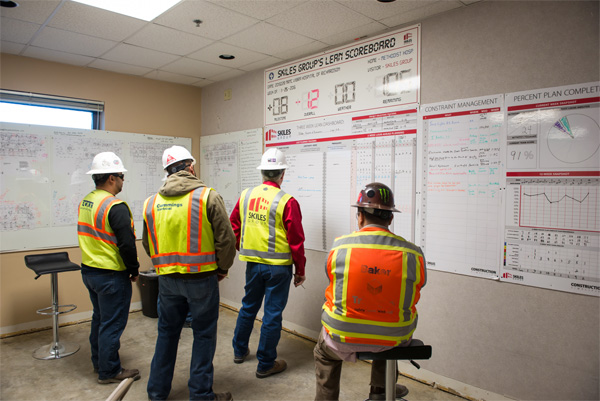The role of project manager in regards to constraint management is to take the lead in helping to alleviate constraints that could slow down or shut down a construction project. Here are some tips from Lean expert, Nathan Wilke, that can help keep your project constraint-free and running smoothly.
The Role of Project Manager in Constraint Management
A superintendent once told me, “I drive the d*mn bus. You keep the lights green.” It took me some time to first understand this and then to truly appreciate it.
This is construction, and there are any number of things that can stop a project from moving forward. Keeping track of what turns those red lights—also known as “constraints”—to green takes organization, discipline, and accountability.In our experience, the best way to manage constraints is by leveraging a visual constraint board.
Visual Constraint Management Board
We hold a 15- or 20-minute daily huddle on all of our projects. One of the things we discuss at those huddles are our current constraints, and we use a visual constraint board that tracks what the constraints are, where they are occurring, who is responsible for fixing them, and when they will be remedied.
The beautiful thing about the constraint board is that by asking and then documenting the answers to those simple question –what, where, who, and when– it clearly tells the story of the potential “red lights” that might slow or even stop a project. As a project manager, it is critical to take lead in helping alleviate those constraints, especially when documentation (RFIs, submittials, or change orders), procurement issues, and manpower issues are involved.
On most projects, the trade partner will call the project manager directly, or maybe send them an email. The operations team will then waste time and money by spending hours trying to solve those problems one at a time, and in a silo.The constraint board solves this by putting the power of problem-solving where it belongs: in the hands of the team.
Trade Partners in Constraint Management
But on my own projects, when this system is clicking well, I have seen a trade partner identify a constraint and write it on the board.Then, after the huddle,I see the other trades immediately work to resolve it, allowing my team to focus on other value-added activities. Watching the collaboration and support that a real team offers to one another is impactful.
Visual Constraint Management Board
One of the best parts of the constraint board is how visible it is. Some people might think that publicly displaying all your constraints for everyone to see is only advertising that you’re not effectively managing your jobs. The reality is that constraints arise on every project, and by bringing people in to help solve these problems -especially the people who are doing the real work of construction- these problems get solved faster, and in a budget-conscious way (that’s the PM coming out in me). Its visibility is part of its power; it keeps everyone in the loop, and nurtures a culture of accountability.
By leveraging a visual constraint board on your project, you will find your roadblocks will quickly be removed, and you will have one happy bus driver that is always pulling into the station on time.
By: Nathan Wilke, CM-Lean
Project Manager, Skiles Group
Follow The Lean Builder on LinkedIn









